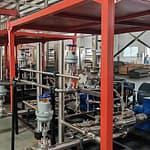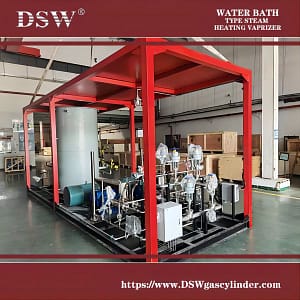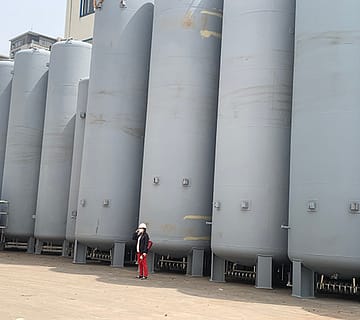Use of Argon Gas in a Wide Range of Applications to Drive Market Growth
The Ar gas is produced by fractional distillation, which involves extracting liquid air from it in a cryogenic unit. It exists as charged ion molecules. Due to its many applications in various industries, it is considered a vital gas.
The metal fabrication industry uses argon gas to shield metals against oxidation when welding. This is due to its non-toxic properties, nonflammability, nonreactivity under extreme temperatures, etc., which drive demand in this sector. Metal fabrication is part of the manufacturing sector and is closely linked to many other industries, including pharmaceuticals, food, beverages, automotive, aerospace, energy and construction.
Metal fabrication has boosted the use of Argon in the steel industry. This is a global trend that continues to grow in all sectors. Below is a graph showing the use of steel by different sectors in 2018. (%).
Use of Steel In Different Sectors, 2018

Use of Argon gas
Here are some specific ways argon gas is used in metal production:
It is used in welding with a mixture of 95% argon gas and 25% carbon dioxide or 98% argon gas and 2% carbon dioxide, depending on the steel type.
It is also widely used in insulated and solar windows to improve energy efficiency. This is driving market growth. It is also used to produce microelectronics using excimer lasers and fluorine. Incandescent bulbs and phosphorescent tubes are also made from it, which is why its demand has increased due to the increase in malls, shopping centres, hotels, etc.
The argon gas is also used in other applications, including producing titanium, germanium, and silicon crystals, as a protective environment, filling dry suits for scuba divers, as an air filler in fire extinguishers, and inflating airbags.
Ar produces reactive metals, such as titanium and zirconium. These metals have a high affinity for oxygen and can readily form oxides when exposed to air. Argon gas is used to create a controlled, oxygen-free environment during various stages of the production process. It helps to prevent oxidation, ensuring the production of high-purity metals with desired properties.
Argon gas is employed as a protective gas during heat treatment processes, such as annealing or hardening of metals. When heated to high temperatures, metals can react with oxygen in the air and form undesirable oxides. Using argon creates an oxygen-free atmosphere, preventing oxidation and maintaining the desired material properties during the heat treatment process.
In metal casting and melting processes, argon gas creates an inert atmosphere in the furnace or casting chamber. The presence of argon gas helps to displace oxygen and moisture, minimizing the formation of oxides and ensuring the production of clean, high-quality castings.
Argon gas is used as a protective atmosphere to produce metal powders. It helps to prevent the oxidation of metal powders during atomization or other powder production processes, ensuring the production of high-purity and stable metal powders.
Here are some common uses of argon gas in the food and beverage industry:
- Wine Preservation: Argon gas is commonly used to preserve opened bottles of wine. When wine is exposed to air, it undergoes oxidation, which affects its taste, aroma, and quality. Injecting argon gas into the wine bottle forms a protective barrier on the surface, preventing oxygen from coming into contact with the wine. This helps maintain the wine’s freshness, flavour, and quality for extended periods.
- Coffee and Tea Preservation: Like wine, coffee and tea can also undergo oxidation when exposed to air. Argon gas is used to displace oxygen from coffee and tea packaging, ensuring the products remain fresh and flavorful. It helps to extend the shelf life and preserve the aroma and taste of the coffee or tea.
- Food Packaging: Argon gas is sometimes used in modified atmosphere packaging (MAP) for certain food products. MAP involves replacing the air inside food packaging with a specific gas mixture to extend the product’s shelf life. Argon gas can be part of the gas mixture to displace oxygen and create an oxygen-free or low-oxygen environment, reducing spoilage and maintaining food quality.
- Dairy Products: Argon gas can displace oxygen and create an inert atmosphere in the production and packaging of dairy products. This helps prevent oxidation and maintain the freshness and quality of dairy products such as milk, cream, and yoghurt.
- Oil and Fat Preservation: Argon gas can also preserve oils and fats, such as cooking or vegetable oils. Injecting argon gas into the packaging forms a protective barrier that minimizes contact with oxygen, preventing oxidation and extending the shelf life of the oils and fats.
Cryogenic Argon
Argon gas condenses to a colourless liquid at −185.8 °C (−302.4 °F) and to a crystalline solid at −189.4 °C (−308.9 °F). The gas cannot be liquefied by pressure above a temperature of −122.3 °C (−188.1 °F); at this point, a pressure of at least 48 atmospheres is required to liquefy.










No comment